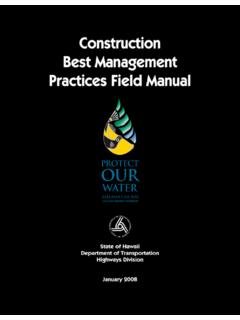Transcription of Filtrexx Inlet Protection (SiltSoxx
1 Construction Activities | Section 1: Sediment & Erosion Control | 17 PURPOSE & DESCRIPTIONF iltrexx SiltSoxx is a three-dimensional tubular sediment control and stormwater runoff filtration device typically used for storm drain Inlet Protection of sediment and soluble pollutants (such as phosphorus and petroleum hydrocarbons) on and around construction activities. Inlet Protection traps sediment and soluble pollutants by filtering runoff water as it passes through the matrix of the Soxx and by allowing water to temporarily pond behind the Soxx, allowing deposition of suspended solids.
2 APPLICATIONI nlet Protection has three distinct applications: around drain inlets, in front of curb inlets, as curb sediment containment systems These applications are described in detail below and shown graphically in Figure and inlets are located in areas that receive runoff from surrounding lands, often exposed and disturbed soils, and are located at a low point, or in a sump. Inlet Protection used around drain inlets (or rain Inlet Protection ) should completely enclose the circumference of the drain and where possible should not be placed on a grade or slope.
3 Inlet Protection used around drain inlets should never be the only form of site sediment control and should be accompanied by erosion control/slope stabilization practices, such as compost erosion control blankets or rolled erosion control blankets. Inlet Protection should never be placed where they divert runoff flow from the drain Inlet , or on top of the Inlet , which can cause flooding. Under high runoff and sediment loading conditions placement of 1-2 in (25-50 mm) diameter rock (AASHTO #2) may be placed around the outer circumference of the Inlet Protection up to the height of the Inlet Protection .
4 This will help slow runoff velocity as it contacts the Inlet Protection and will reduce sediment build-up and clogging of the Inlet inlets are generally located on paved surfaces and are designed to rapidly drain storm runoff from roadways to prevent flooding that poses a hazard to vehicular traffic. Inlet Protection devices should be placed in a manner which intercepts runoff prior to entering the Inlet , but does not block or divert runoff from the Inlet . To prevent diversion of runoff, Inlet Protection used around curbs (or curb Inlet Protection ) should be used in low points, or sumps, and minor slopes or grades.
5 Inlet Protection should never be placed in or on the curb Inlet drain, or placed in a manner that obstructs vehicular traffic. Inlet Protection height should be at least 1 in (25 mm) lower than top of curb Inlet to allow for overflow into the drain and not over the curb. Maximum sediment removal efficiency occurs when minor ponding exists behind Inlet Protection but should never lead to flooding. Curb sediment containment systems are used to reduce the sediment and pollutant load flowing to a curb Inlet . They are generally placed on paved surfaces perpendicular to runoff flow and should be lower than the height of the curb.
6 Curb sediment containment systems should never cause flooding or placed where they are a hazard to vehicular traffic. Inlet Protection used for curb sediment containment (or curb sediment containment Inlet Protection ) can be Curb Inlet Protection Fine Silts FiltrationSECTION 1: CONSTRUCTIONF iltrexx Inlet Protection (SiltSoxx )18 | Filtrexx Design Manual | Version placed on a grade but should never be placed directly upslope from curb Inlet where it may inadvertently divert runoff from entering curb Inlet . ADVANTAGES AND DISADVANTAGESA dvantages Tubular filtration matrix allows for better trapping and removal of sediment and soluble pollutants in stormwater runoff compared to planar constructed sediment control devices, such as silt fences.
7 Inlet Protection can be installed on soil or paved surface conditions. Greater surface area contact with soil or pavement than typical sediment control devices, reducing potential for runoff to undercut the device leading to unfiltered sediment. No trenching is required; therefore soil is not disturbed upon installation. Drain Inlet Protection can be installed year- round in difficult soil conditions such as frozen or wet ground, and dense and compacted soils, as long as stakes can be driven. Inlet Protection is easily implemented as a treatment in a greater treatment train approach to erosion and sediment control.
8 Organic matter and humus colloids in FilterMedia have the ability to bind and adsorb phosphorus, metals, and hydrocarbons that may be in stormwater runoff. Microorganisms in compost FilterMedia have the ability to degrade organic pollutants and cycle captured nutrients in stormwater runoff. Soxx (mesh netting containment system) allows Inlet Protection to be placed in areas of high sheet flow and low concentrated flow. Drain Inlet Protection can be direct seeded at time of application to provide greater stability and filtration capability once vegetation is established, if used on soil surface.
9 FilterMedia is organic and can be left on site soil after permanent stabilization is complete, to be used in landscape design and/or seeded and planted with permanent vegetation. FilterMedia improves existing soil structure if spread out and used as a soil amendment after construction activity is complete. Biodegradable Inlet Protection can be left on site after construction activity and may eliminate the need for removal and labor and disposal costs. Inlet Protection is available in 8 in (200mm), 12 in (300mm), 18 in (450mm), 24 in (600mm), and 32 in (800mm) diameters.
10 Inlet Protection may assist in qualification for LEED Green Building Rating and Certification credits under LEED Building Design & Construction (BD+C), New Construction v4. Awarded credits may be possible from the categories of Sustainable Sites, Water Efficiency, Materials & Resources, and Innovation. Note: LEED is an independent program offered through the Green Building Council. LEED credits are determined on a per project basis by an independent auditing committee. Filtrexx neither guarantees nor assures LEED credits from the use of its is a trademark of the Green Building Council.

